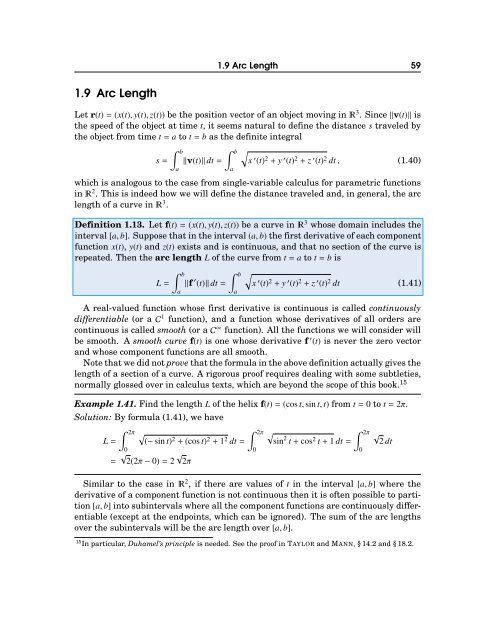Michael Corral: Vector Calculus
Michael Corral: Vector Calculus
Michael Corral: Vector Calculus
Create successful ePaper yourself
Turn your PDF publications into a flip-book with our unique Google optimized e-Paper software.
1.9 Arc Length 59<br />
1.9 Arc Length<br />
Let r(t)=(x(t),y(t),z(t)) be the position vector of an object moving in 3 . Since‖v(t)‖ is<br />
the speed of the object at time t, it seems natural to define the distance s traveled by<br />
the object from time t=ato t=bas the definite integral<br />
∫ b ∫ b √<br />
s= ‖v(t)‖dt= x ′ (t) 2 +y ′ (t) 2 +z ′ (t) 2 dt, (1.40)<br />
a<br />
a<br />
which is analogous to the case from single-variable calculus for parametric functions<br />
in 2 . This is indeed how we will define the distance traveled and, in general, the arc<br />
length of a curve in 3 .<br />
Definition 1.13. Let f(t)=(x(t),y(t),z(t)) be a curve in 3 whose domain includes the<br />
interval[a,b]. Supposethatintheinterval(a,b)thefirstderivativeofeachcomponent<br />
function x(t), y(t) and z(t) exists and is continuous, and that no section of the curve is<br />
repeated. Then the arc length L of the curve from t=ato t=bis<br />
L=<br />
∫ b<br />
a<br />
‖f ′ (t)‖dt=<br />
∫ b<br />
a<br />
√<br />
x ′ (t) 2 +y ′ (t) 2 +z ′ (t) 2 dt (1.41)<br />
A real-valued function whose first derivative is continuous is called continuously<br />
differentiable (or aC 1 function), and a function whose derivatives of all orders are<br />
continuous is called smooth (or aC ∞ function). All the functions we will consider will<br />
be smooth. A smooth curve f(t) is one whose derivative f ′ (t) is never the zero vector<br />
and whose component functions are all smooth.<br />
Notethatwedidnotprovethattheformulaintheabovedefinitionactuallygivesthe<br />
length of a section of a curve. A rigorous proof requires dealing with some subtleties,<br />
normally glossed over in calculus texts, which are beyond the scope of this book. 15<br />
Example 1.41. Find the length L of the helix f(t)=(cost,sint,t) from t=0to t=2π.<br />
Solution: By formula (1.41), we have<br />
L=<br />
∫ 2π<br />
0<br />
√<br />
(−sint) 2 +(cost) 2 +1 2 dt=∫ 2π<br />
= √ 2(2π−0)=2 √ 2π<br />
0<br />
√ ∫ 2π √<br />
sin 2 t+cos 2 t+1dt= 2dt<br />
0<br />
Similar to the case in 2 , if there are values of t in the interval [a,b] where the<br />
derivative of a component function is not continuous then it is often possible to partition<br />
[a,b] into subintervals where all the component functions are continuously differentiable<br />
(except at the endpoints, which can be ignored). The sum of the arc lengths<br />
over the subintervals will be the arc length over [a,b].<br />
15 In particular, Duhamel’s principle is needed. See the proof in TAYLOR and MANN, §14.2 and §18.2.








